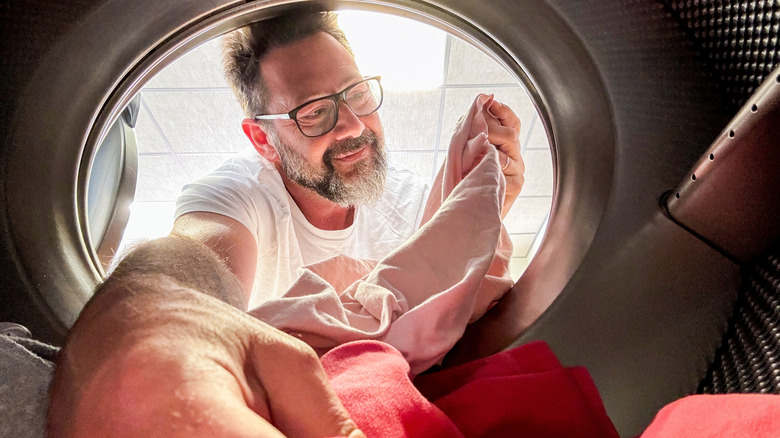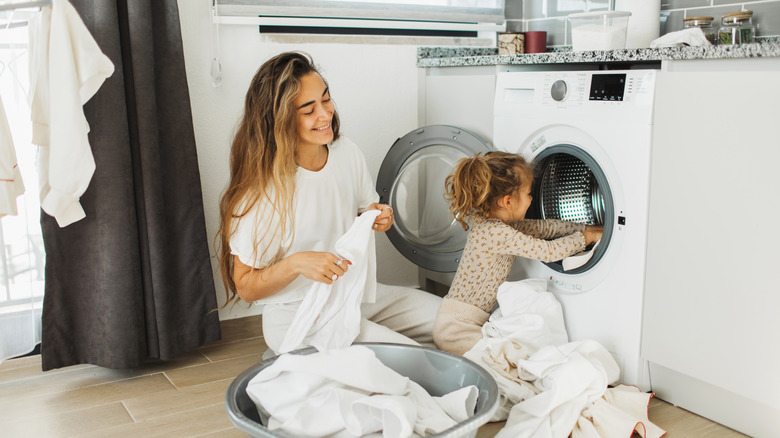Is It Cheaper To Do Laundry At Home Or At A Laundromat?
We may receive a commission on purchases made from links.
According to Statista, 70% of households in the U.S. own laundry machines, representing %65 billion in sales in 2023. Out of that, only 18% are smart machines — Energy Star certified appliances that automatically gauge things like energy usage and needed maintenance — which can save owners a combined $54 a year on their energy bills when washers and dryers are considered. Washers and dryers are also appliances you should never buy used.
On the other side of the coin are laundromats. In 2021, laundromats had a value of $5 billion in the U.S. with about 30,000 laundromats and rising — the amount of laundromats is growing by one to two percent every year. That growth might have something to do with the relatively high profit margins of anywhere from 20% to 35% for owners. Thanks to the everyday need for clean clothes, and the availability plus affordability of your neighborhood laundromat, owners are averaging $30,000 to as much as one million dollars in revenue every year.
While these numbers sound great for the laundry machine manufacturers and laundromat owners, what does it actually mean for you, the consumer? Here are our thoughts on whether it's cheaper to do laundry at home or at a laundromat.
What are the upfront costs of washers and dryers?
Before you can do any laundry at home, you'll have to first purchase the appliances assuming you have the space. Since manufacturers tend to build washing machines that are compatible with their dryers, it would be a good idea to buy both from the same manufacturer, since specialized hardware could complicate maintenance between two incompatible appliances. Purchasing a pair of washing machines can also save you money on bundle pricing. We've explained why extended warranties may not be worth the splurge, however, if you chose to purchase a warranty with your machines, the Geek Squad at Best Buy offer additional washer and dryer protection for $99.99 for a three year plan, or $139.99 on five year plan.
When it comes to the actual machines, whether a front-load washer or top load washer, you can expect to spend anywhere from $450 to $2,200. Even if you try to get the best of both worlds by purchasing an all-in-one washer and dryer, you can still expect to spend between $1,400 to $1,800. If your dryer is a gas dryer, you may spend $100 more in upfront costs plus an additional $20 per linear foot if you need a gas hook up. In fact, the installation of a gas line, should you need one, could add as much as $1,000 in upfront costs. No vents, water, or drainage connections? That could be another $500 to $2,000 — and you haven't paid for the actual dryer yet.
The costs of doing laundry at home versus a laundromat
Americans, on average, spend $4.00 at their local laundromat versus an average $2.50 on laundry at home. Once you throw in transportation, detergent and dryer sheets, doing your laundry at the laundromat becomes more like $5.21 per load. At an average eight loads per week, that lands at around $41.68 per week. This is the equivalent of just over $2,000. Obviously, doing laundry at home doesn't require coins, so the equivalent cost of doing a load of laundry is about $1.37 or $10.90 per week. That adds up to $43.60 per month, or $523.20 per year.
Obviously, doing laundry at home looks like the cheaper choice. Of course, that assumes you can afford all the potential upfront costs of owning a washer and dryer. In other words, your financial means have more to do with this question than anything else. Technically however, if you consider that most machines have an average lifespan of 10 years, if you can afford the initial costs, doing laundry at home is the cheaper way to go. Otherwise, keep going to the laundromat, and figure out other ways to save money and time, like trying the sartorial rule many successful people follow.


